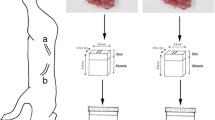Abstract
A retrospective study on the prevalence of ostrich carcass and organ condemnations in Botswana was conducted by reviewing meat inspection records available at the Botswana Ostrich Company Abattoir in Gaborone for the 3 year period that the abattoir had been in operation. The most frequently condemned organs were lung (85.1%), liver (8%), intestine (3.3%), heart (2.7%) and kidney (0.8%). The most frequently encountered macroscopic findings were contamination (80%), congestion (10%), enteritis (3%), haemorrhage (2%), pigmentation (2%), white spots on the liver (1%) and peritonitis (1%). The frequencies of the various macroscopic findings on all the organs increased over the 3 years of the study. Ninety-five percent (95%) of the findings were all abattoir associated, especially the external contamination of organs (80%). The 5% that were acquired during the lifetime of the birds included enteritis, peritonitis and white spots on the liver. No whole carcass condemnations or carcass trimmings were recorded, nor where there any zoonotic causes of condemnation.



Similar content being viewed by others
References
Anonymous 2000. Despite an attack by anthrax, ostrich cultivation remains prospective. Indonesian Commercial Newsletter, January 31.
Bergmann V., Koglin K., and Valentin A. 1995. Skin diseases as a reason for condemnation of broiler carcasses. Tierarztl Prax., 234: 374–80.
Bisaillon J.R., Meek A.H. and Feltmate T.E. 1988. An assessment of condemnations of broiler chicken carcasses. Canadian Journal of Veterinary Research, 52(2):269–76.
Capua I., Mutinelli F., Terregino C., Cattoli G., Manvell R.J. and Burlini F. 2000. Highly pathogenic avian influenza (H7N1) in ostriches farmed in Italy. Veterinary Record, 146:356.
Chambers P.G. 1987. Carcass and offal condemnations at meat inspection in Zimbabwe. Zimbabwe Veterinary Journal, 18:11–18.
Deeming D. C. 1999. The Ostrich Biology, Production and Health, CABI Publishing, Wallingford, New York.
Edwards D.S., Christiansen K.H., Johnston A.M. and Mead G.C. 1999. Determination of farm-level risk factors for abnormalities observed during post-mortem meat inspection of lambs: a feasibility study. Epidemiology and Infection, 123: 109–119. doi:10.1017/S0950268899002630
Gray M.L., Puette M. and Latimer K.S. 1998. Microsporidiosis in a young ostrich (Struthio camelus). Avian Diseases, 42: 832–836. doi:10.2307/1592726
Green L.E, Berriatua E. and Morgan K.L. 1997. The relationship between abnormalities detected in live lambs on farms and those detected at post mortem meat inspection. Epidemiology and Infection, 118: 267–273. doi:10.1017/S0950268897007401
Herenda D. and Jackel O. 1994. Poultry Abattoir Survey of Carcass Condemnation for Standard, Vegetarian, and Free Range Chickens. Canadian Veterinary Journal, 355:293–296.
Huchzermeyer F.W. 1997. Public health risks of ostrich and crocodile meat. Revue Scientifique et Technique, 16(2): 599–604.
Jacob H.P, Morgenstern R., Albicker P. and Hoop R.K. 1998. Reasons for condemnation of slaughtered broilers from two large Swiss producers. Schweiz Arch Tierheilkd, 140(2): 60–64.
Mallia J.G., Vaillancourt J.P., Martin S.W. and Mcewen S.A. 2000. Risk factors for abattoir condemnation of turkey carcasses due to cyanosis in southern Ontario. Poultry Science, 79(6): 831–837.
Mosienyane M.G. 1986. A survey of Cysticercus bovis (measles) infestation in cattle sent for slaughter to Botswana Meat Commission (BMC); a ten years retrospective study-1974–1983. International Journal of Zoonoses, 13: 124–130.
Pfukenyi D.M. and Mukaratirwa S. 2004. A retrospective study of the prevalence and seasonal variation of Fasciola gigantica in cattle slaughtered in the major abattoirs of Zimbabwe between 1990 and 1999. Onderstepoort Journal of Veterinary Research, 71: 181–187.
Roberts J.A. and Suhardono S. 1996. Approaches to the control of fasciolosis in ruminants. International Journal for Parasitology, 26: 971–981.
Roepstorff A., Eriksen L., Slated H.C. and Nansen P. 1997. Experimental Ascaris suum infection in the pig: worm population kinetics following single inoculations with three doses of infective eggs. Parasitology, 115 Pt 4: 443–52.
Sevcikova Z., Ledecky V., Capik I., Levkut M. 1999. Unusual manifestation of tuberculosis in an ostrich (Struthio camelus). Veterinary Record, 145(24): 708.
Schoon, H.A, Brunckhorst D. and Pohlenz J. 1991. Spongiform encephalopathy in a red-necked ostrich (Struthio camelus). Tierärztliche Praxis, 19(3): 263–5.
Snowden K. and Logan K. 1999. Molecular identification of Encephalitozoon hellem in an ostrich. Avian Diseases, 43: 779–782.
Swanepoel R., Leman P.A., Burt F.J., Jardine J., Verwoerd D.J., Capua I., Brückner G.K. and Burger W.P. 1998. Experimental infection of ostriches with Crimean-Congo haemorrhagic fever virus. Epidemiology and Infection, 121(2): 427–432.
Taylor L.H., Latham S.M., and Woolhouse M.E. 2001. Risk factors for human disease emergence. Philosophical Transactions of the Royal Society B: Biological Sciences, 356: 983–9.
Vanhooser S.L. and Welsh R.D. 1995. Isolation of Salmonella species from ratites. Journal of Veterinary Diagnostic Investigation, 7:268–269.
Vassilev G. and Jooster R. 1991. Production losses and control of fasciolosis in cattle in Zimbabwe. Zimbabwe Veterinary Journal, 22: 45–51.
Acknowledgements
We extend our sincere gratitude to Management and Meat inspection personnel at the Botswana Ostrich Company in Gaborone for allowing us access to slaughter records. Dr Motsamai is also greatly thanked for facilitating access to the records.
Author information
Authors and Affiliations
Corresponding author
Rights and permissions
About this article
Cite this article
Dzoma, B.M., Pansiri, E. & Segwagwe, B.V.E. A retrospective study on the prevalence of ostrich carcass and organ condemnations in Botswana. Trop Anim Health Prod 41, 443–448 (2009). https://doi.org/10.1007/s11250-008-9206-6
Received:
Accepted:
Published:
Issue Date:
DOI: https://doi.org/10.1007/s11250-008-9206-6




